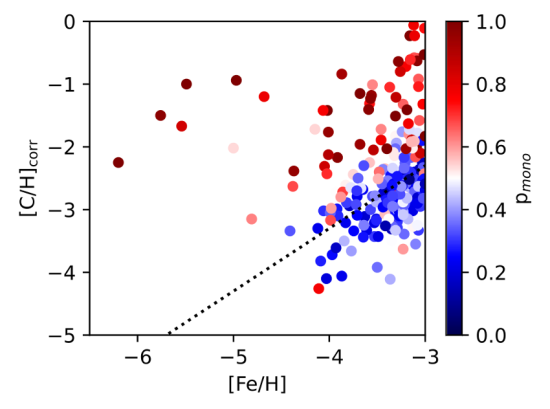A team of astrophysicists led by the University of Tokyo used machine learning to analyze
Most elements are heavier than carbonuniverse, are produced by supernova explosions. The first stars did not have such heavy elements, they had a low metallicity. The next generation of stars contained only a small amount of the heavy elements produced by the first stars. Stars like the Sun are third generation and contain even more of these elements.
Researchers studied 450 stars in the Milky Way withextremely low metallicity characteristic of second-generation stars. It is believed that they were formed as a result of supernova explosions, which ended the evolution of the first stars in the universe. The astrophysicists used a trained neural network to test whether these stars were formed by one or more explosions.
 Results of analysis of the composition of different stars.Red stars were formed as a result of the explosion of several supernovae, blue stars contain elements of one explosion. Image: Hartwig et al., The Astrophysical Journal
Results of analysis of the composition of different stars.Red stars were formed as a result of the explosion of several supernovae, blue stars contain elements of one explosion. Image: Hartwig et al., The Astrophysical Journal
Using a specially developed algorithmmachine learning trained on theoretical models of supernova nucleosynthesis, they found that 68% of observed extremely low metal stars have a chemical fingerprint consistent with the enrichment of several previous supernovae.
The theory of the first stars tells us that they mustbe more massive than the sun. The natural expectation was that the first star was born in a gas cloud, the mass of which is a million times greater than that of our star. However, our discovery convincingly proves that the first stars were not born singly, but formed as part of a star cluster, binary or multiple star system.
Chiaki Kobayashi, study co-author at the University of Hertfordshire
The researchers note that these resultsare based only on a small sample of closely spaced stars. Observations of second-generation stars with powerful telescopes in the coming years will confirm this theory.
Read more:
Scientists believe that the shape of the universe is not what everyone thinks
NASA helicopter showed sunset on Mars. It doesn't look like earth.
Named a plant whose extract helps to lose weight without side effects
On the cover: an artistic illustration of the birth of stars at the edge of explosions of several nearby supernovae. Image: Kavli Institute for the Physics and Mathematics of the Universe